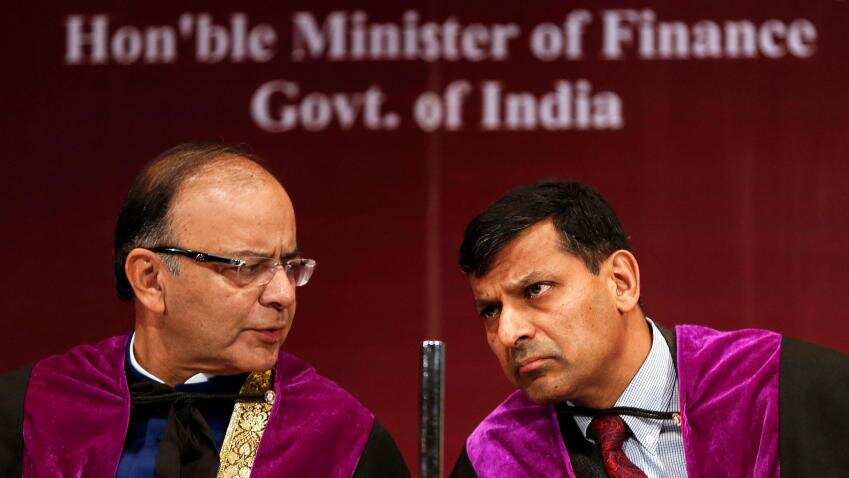Rajan’s exit will lead to an era of cheap money
Buoyed by Jaitley’s 2015 Union Budget, Rajan complemented the government by his second surprise out of turn rate cut on March 4, 2015. "Given low capacity utilisation and still-weak indicators of production and credit off-take, it is appropriate for the Reserve Bank to be pre-emptive in its policy action," he had said.

The biggest friction between Raghuram Rajan-led Reserve Bank of India (RBI) and Arun Jaitley’s finance ministry was interest rates.
Rajan, time and again maintained status-quo when it came to interest rates while Jaitley and his ministry frequently asked for the RBI to cut rates. Rajan’s reason was simple: tackling inflation. And for Modi government, the agenda was to boost India’s growth.
Higher interest rates mean cost of money is high which dissuades industry from borrowing. However, cutting rates mean money gets cheaper which in turn spurts spending resulting in higher inflation.
As early as in October 2014, Jaitley told the Times of India, "Currently, interest rates are a disincentive. Now that inflation seems to be stabilising somewhat, the time seems to have come to moderate the interest rates." Rajan, however, maintained that interest rates won’t be cut unless consumer inflation can be controlled under 6% by January 2016.
In December 2014, Jaitley again nudged the RBI to cut rates on the back of moderating inflation. RBI, although left rates unchanged in its policy, promised to relook easing next year.
Rajan did come true to his promise when he cut rates on January 15 by 25 basis points. This was out of turn as the bi-monthly monetary policy was slated for February 3, 2015.
Rajan cited comfortable retail inflation and Modi government’s commitment to fiscal deficit target as the reason for this surprise rate cut.
Buoyed by Jaitley’s 2015 Union Budget, Rajan complemented the government by his second surprise out of turn rate cut on March 4, 2015. "Given low capacity utilisation and still-weak indicators of production and credit off-take, it is appropriate for the Reserve Bank to be pre-emptive in its policy action," he had said.
By now, a 50 basis points cut meant that repo rate in India stood at 7.50%.
Union Minister of State for Finance Jayant Sinha, too, joined the chorus and in April 2015 said that the RBI should look into interest rates as they must come down.
The following monetary policy saw another 25 basis point cut and a whopping 50 basis points cut in September 2015 mean repo rate came down to 6.75%.
Moreover, Jaitley’s pressure on RBI to cut rates to stimulate growth was growing as India’s economic growth slowed to 7% June 2015 quarter from 7.5% in the quarter before.
In April this year, Jaitley again publicly expressed his expectation from the RBI to cut rates.
He was quoted as saying, “I want what everybody wants.” Rajan followed through again with a 25 basis points cut.
RBI maintained status quo in its June policy and repo rate currently stands at 6.50%.
However, something else was happening in the Indian economy by now—transmission problem.
RBI had cut its repo rate by 125 basis points but banks didn’t follow through.
They cited tight liquidity, high deposit rates and mounting bad loans issue as reasons for not cutting their interest rates. Although, banks are now slowly bringing down their lending rates under the new marginal cost of funds lending rates (MCLR) regime introduced by the RBI but the gap between repo rate and banks' lending rates is still quite wide.
By seeing the relationship shared by Rajan and finance ministry over the past two years, it is amply clear that the tussle has been between boosting growth by cutting interest rates and controlling inflation.
However, with Rajan deciding not to consider a second term, Centre is expected to appoint a Governor more aligned towards its vision. Moreover, the monetary policy committee (MPC), which will have four out of its seven members appointed by the Government will also toe the line.
Yes, the new governor of the RBI will have a deciding vote in case the MPC fails to reach a decision, one can fathom in which way that tide is going to turn.
Deepali Bhargava, an economist with Credit Suisse, on June 20, wrote, “With the new appointment, we do not think that the government intends to challenge or alter the current monetary policy framework that has been approved by the parliament. But the aim could be simply to bring in someone more amenable to the government.”
“It could mean higher likelihood of further rate cuts (against our expectations of none for the rest of the year) as long as CPI inflation remains in the targeted range of 2-6%,” she added.
Get Latest Business News, Stock Market Updates and Videos; Check your tax outgo through Income Tax Calculator and save money through our Personal Finance coverage. Check Business Breaking News Live on Zee Business Twitter and Facebook. Subscribe on YouTube.
04:58 PM IST











 Rajan's exit will not hamper India's GDP: World Bank
Rajan's exit will not hamper India's GDP: World Bank RBI will survive any Governor, do not personalise it: Raghuram Rajan
RBI will survive any Governor, do not personalise it: Raghuram Rajan  India Inc looks at banks but will they oblige with rate cuts?
India Inc looks at banks but will they oblige with rate cuts?  Has Rajan subtlety hinted at no more rate cuts?
Has Rajan subtlety hinted at no more rate cuts? How the who's who of politics and financial markets reacted to Rajan's exit
How the who's who of politics and financial markets reacted to Rajan's exit